“Single-use plastics are the devil!”
I stood in the pharmacy aisle, staring at the dental floss picks in disbelief. Twenty different brands, all with plastic handles wrapped in cellophane, all of them destined to be used once then thrown away.
I’d just come from a visit to the dental hygienist who’d told me to I needed to floss. She’d even recommended these picks because they’re easier to use than regular floss – but I couldn’t bear the idea of wilfully buying something so environmentally wasteful.
Five minutes of deliberation later, I eventually had to turn around and walk out of the store, my vow to improve my dental hygiene melting away.
It got me thinking about the choices I make when it comes to eco-friendly products. A lot of factors in my regular life at home are chosen on the basis of their environmental impact: I shop in charity shops and thrift stores for clothes; I recycle plastics and organic waste — and clearly I’m growing increasingly conscious of how much plastic I buy.
But how do I manage to be eco-friendly when I travel?
Travelling is, in essence, an environmental problem – from a plane ride’s damaging carbon emissions to the excessive amount of waste generated by millions of tourists in countries ill-equipped to dispose of it.
Luckily, there are countries combatting the tourism crisis with bans on single-use plastic and aims to become entirely climate-neutral – but we still have a responsibility as individuals.
When travelling, we can be more eco-conscious by turning off the lights, picking up our rubbish, using public transport, and being conscious of the amount of water we use. In short, all the things we (hopefully!) already do at home. We can eat locally, travel more slowly, and buy from independent retailers.
But the biggest personal change we can make is to simply stop using so much. If single-use items grow less popular, eventually we’ll see a marked difference in our efforts to combat waste.
Over the years I’ve amassed a selection of products which make my travels a bit more eco-friendly. I know from personal experience that they’re all affordable, durable and worth the money you’ll spend – and each of them helps the environment in their own way.
Read more: Ethical mistakes I’ve made while travelling
Reusable bag
When I was younger, I used to watch my mum carrying multiple bags everywhere she went. I used to joke and call her ‘a bag lady’ – but now I remember that her newspapers, groceries and extra layers were always in tote bags, never plastic.
A brand she particularly loved was Onya. In an effort to challenge our disposable culture, Onya use yarn made from recycled plastic bottles to make reusable bags. Mum gave me a blue Onya bag over a decade ago, and despite it getting increasingly stained and worn out, that same bag is still going strong fifteen years later.
The silky material means it’s super light and folds up to barely anything: as a result, it’s been stuffed into my pack throughout long-term travels in Asia and South America, has visited dozens of other countries and is always in my bag even when I’m in London. There’s nothing like the ‘internal-high-five’ I feel when I successfully avoid using a plastic bag in a shop!
Onya now only sell their products in Australia, but there are plenty of other reusable bags out there – like Baggu bags and these foldable totes from Bee Green.
TOMS slipon shoes
I first discovered TOMS shoes when living in San Francisco in 2009, when I put them on and immediately felt like I was walking on clouds.
I virtually wore out that first pair while traipsing the SF cement, the bright lights of Vegas, the Chicago cityscape and the muggy air of New Orleans – and when I brought them back to England, I continued wearing them around my university town until my toes got too cold (alas they’re only really suitable for warmer temperatures). Eventually TOMS were stocked in the UK and now I find myself buying a pair every summer.
The classic TOMS are lightweight which makes them easy to pack, they’re comfortable for a full day of walking around, and they look casual-smart enough to wear in a range of different scenarios. They’re made from natural hemp, organic cotton and recycled polyester, while their shoeboxes are made from recycled post-consumer waste.
But most importantly, TOMS operate under a ‘Buy One, Give One’ model: for every purchase you make, they donate a pair of shoes to a child in poverty. As of today, TOMS have given away 86 million pairs of shoes to children – and most recently the founder, Blake Mycoskie, has donated $5 million towards ending gun violence in the US.
NB: If you’re a US citizen, you can go to TOMS.com and send a physical postcard to your Congress representative urging them to pass universal background checks.
LUSH solid shampoo and conditioner
Travel-sized toiletries, though somewhat adorable in stature, have always felt like a huge waste of plastic. Despite only washing my hair twice a week I still run out of travel sized shampoo on long trips – and if I travel with carry-on only, there’s no way I’m using up my liquid allowance with a full sized bottle of shampoo!
Enter: solid shampoo. This stuff can take some getting used to at first, but it’s an undeniably useful product to travel with. A single LUSH Solid Shampoo Bar can last for about 80 washes and is made from natural ingredients and essential oils.
I store mine in a silver tin which doubles as somewhere to place the bar when showering (if there’s a ledge available). Simply run the bar a few times over wet hair to create a lather. Make sure you don’t pack the bar away when still damp though, as it can melt away a bit. I’ve patted mine dry with toilet paper then had to pick tiny specks of paper off it again – so any tips aside from air-drying are welcome!
Go-Toob squeeze bottles
If you’re like me and have really dry hair, sometimes you have to use a particular brand of liquid shampoo – which is where Go-Toob comes in handy.
Most refillable bottles are hard plastic, making it really difficult to shake out whatever substance you’ve got inside. Go-Toobs are soft, squeezable, reusable bottles made from silicone, with a wide lip for easy filling and a no-leak valve. They’re small enough for airline carry-on, easy to wash out before reusing, and there’s even a designated space on the cap to write what product is inside.
I first picked up a trio of Go-Toob’s reusable bottles when I was packing for South America, and now they’re a requisite element of my travel wash bag. One holds shampoo, another has body moisturiser, and the third is a spare for suncream or whatever else I might need.
Reusable water bottle
Reusable water bottles are one of the easiest eco-friendly switches to make: they’re cheaper than buying bottled water and they greatly reduce wasted plastic.
I have a few in my collection: two different sizes of Ion8 bottles made from BPA-free plastic, and two metal bottles from Klean Kanteen – one with a wide lip and one with a sports cap. I find the latter easiest for travel because although a wide-lipped bottle is aesthetically appealing, it has the ability to jolt against my teeth if I’m not standing perfectly still. After an accident in the school playground where I broke my front tooth, I’m now really cautious about possible teeth-related accidents!
A word of warning when travelling: always check whether the tap water is safe to drink. If you’re unsure, you can use water purification tablets or a LifeStraw.
Mooncup
After years of worrying about developing Toxic Shock Syndrome from tampons, I started using a menstrual cup when I went to South America and I’ve never looked back.
For female travellers, menstrual cups are a no-brainer: gone are the days of using up precious backpack space with tampons, or running the risk of not being able to buy them in your destination. But they’re really eco-friendly too. The average person goes through approximately 11,000 pads and/or tampons in their lifetime, all of which end up in landfill: in comparison, you only need to replace your menstrual cup every few years.
A Mooncup is made of soft medical-grade silicone which you fold and put inside yourself, where it then pops into its original shape and creates a seal with your cervix. To remove, you simply pinch the base of the cup and pull on the stem, then empty it out and clean before using again (a tip: it’s handy to take a water bottle to public toilets for this part!).
It’s understandably a bit nerve-wracking to use a menstrual cup the first few times, but you get the hang of it pretty quickly. And again, Mooncups give you longer lasting protection than other sanitary products so when you’re travelling and don’t have constant access to a toilet, there’s no panic about changing it in time! If you’re someone like me, who often suffers from thrush (which once happened after using a tampon for too long on an 18 hour night bus ride from Poland to Lithuania with a locked on-board toilet and no stops…), the non-absorbency of a menstrual cup means no dryness, which is also a lifesaver.
There are two sizes of Mooncup: choose A if you’re aged 30 or older or have given birth vaginally at any age, and B if you’re under 30 and haven’t given birth.
THINX underwear
The second element to my eco-friendly period game are THINX: period underwear which are made with various absorbent materials to prevent any leaks. I ordered two pairs of these babies all the way from the US. Shipping costs were a bit of an annoyance, but nonetheless they’re bloody fantastic. Pun intended.
THINX are only slightly thicker than normal underwear, and come in six different styles with various levels of absorbency, including bikinis, boy shorts and thongs. I wear them along with my Mooncup for maximum peace of mind on the first few days of my cycle, but they’re also great to use before your period arrives so you can avoid spotting in regular underwear.
Cleaning THINX is pretty easy: just soak them in cold water first and then either handwash or chuck them in a cold washing cycle without fabric softener (as it can affect the antimicrobial materials). They do take a while to air dry, so it’s worth having more than one pair.
As with menstrual cups, using period underwear saves you using non-recyclable one-use sanitary products which end up in landfill.
(NB: If you’d be interested in an honest review about my experiences with THINX, let me know in the comments!)

 Ethnotek backpack
Ethnotek backpack
My favourite backpack brand is Ethnotek, an ethically responsible social enterprise which use handmade textiles from artisans all over the world, from Vietnam and Ghana to Indonesia, Guatemala and India.
I’d been following Ethnotek for a long time, but I was finally able to meet the two founders, Cori and Jake, in Bali earlier this year. We had brunch in an Ubud cafe and chatted about their passion for keeping traditional handcraft practices alive.
Sadly many local artisans are seeing less and less demand for their work, with handmade products being replaced by factories and machines which leads to loss of jobs and ultimately the disappearance of handicrafts. That’s why it’s so important to see Ethnotek creating new demand for these traditional practices by featuring tie-dye, batik, block printing, embroidery and handloom weaving on its bags.
Reusable cotton rounds
Once I realised how wasteful it is to use disposable face wipes, cotton balls and cotton pads, I spent ages searching the internet high and low for reusable alternatives. It took a long time to find a stockist who wasn’t in the US and could deliver to England, but eventually Etsy came to my rescue.
A set of organic cotton rounds easily replace other single-use products: simply pop your cleanser or toner on the pad and use as normal, but then put them in the wash afterwards (courtesy of the thoughtfully included laundry bag!). Mine are made from two layers of cotton, along with a layer of antibacterial bamboo towelling on one side: as it’s slightly rougher, it removes more makeup!
My only issue with reusable cotton rounds is that some of them have stained slightly from over use, so I’d recommend handwashing them with some soap and warm water sooner rather than later.
Bamboo toothbrush
You know there’s a global crisis when a company willingly gives away their product for free in the hopes of changing people’s minds for the better.
When I saw an advert from ‘Giving Brush’ on Facebook I didn’t believe them at first – but when my free bamboo rainbow toothbrush arrived in the mail a few weeks later, I suddenly realised how irresponsible it is to use plastic toothbrushes which need to be changed every few months.
The handle is made from bamboo, a natural plant-based material so it will eventually biodegrade, and the bristles are made from nylon – not super recyclable, although some companies use the biodegradable ‘nylon4’.
What eco-friendly products do you travel with? Is there any product you wish could become more environmentally conscious?
Disclaimer: this article contains affiliate links. If you make a purchase through these links I will earn a small commission at no cost to you.

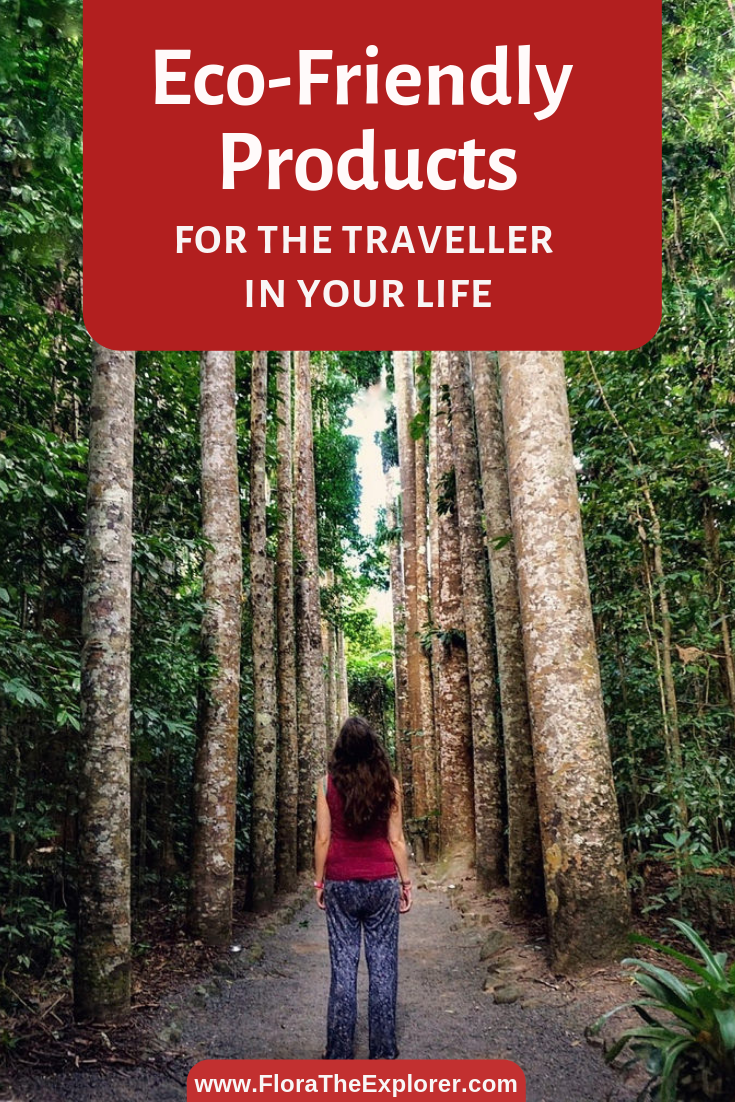


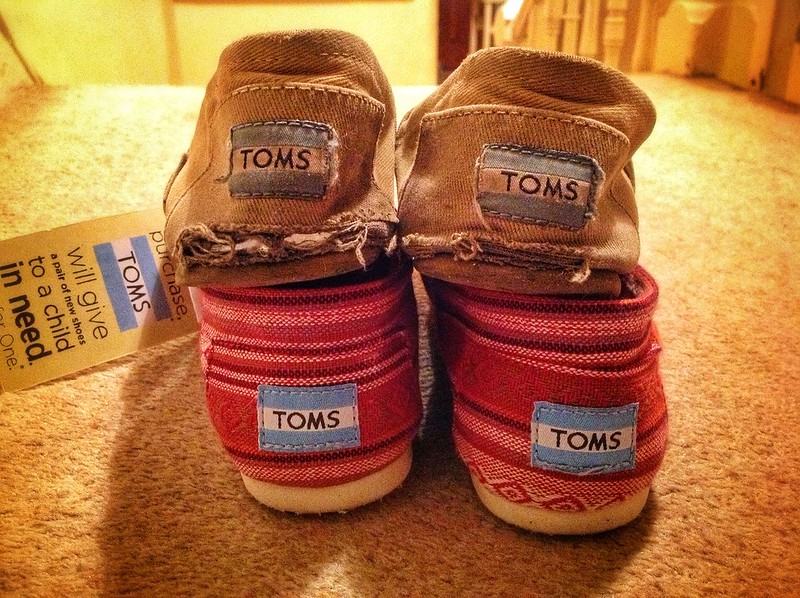




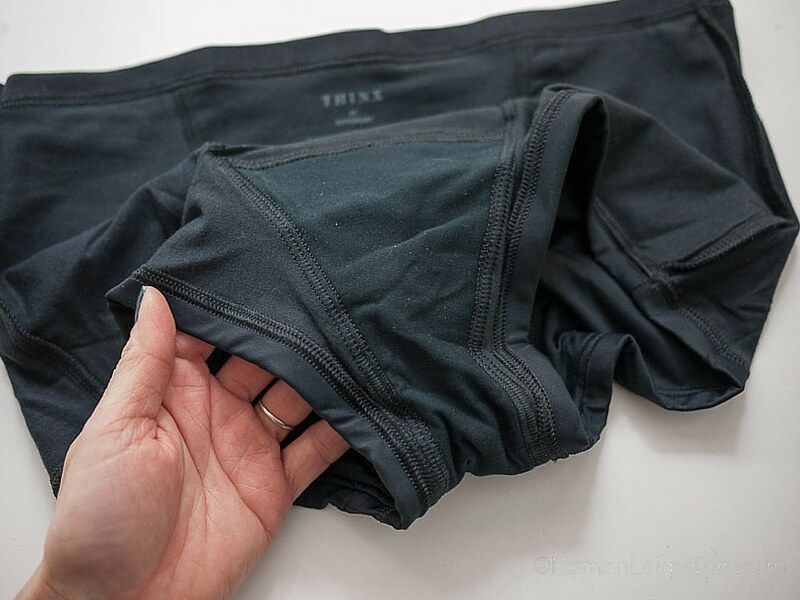



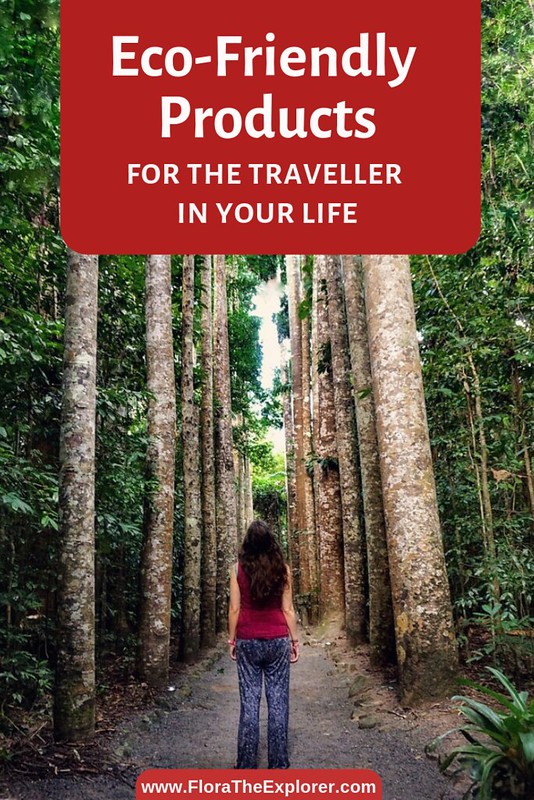
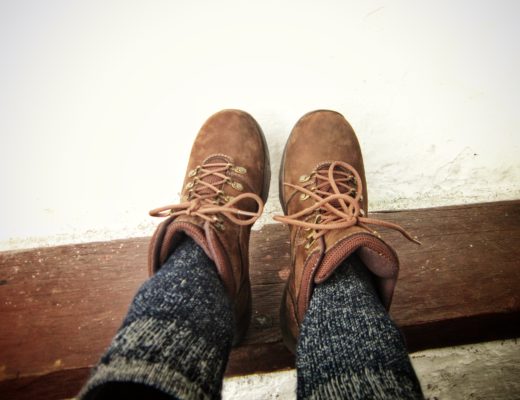
19 Comments
Dagney
November 24, 2018 at 10:40 pmLove that these items are eco-friendly! Lush is my absolute fave shampoo, it’s eco friendly and lasts forever! I’ve been using it for years, and I’m so glad it’s finally catching on! My other go-to is Playtpus water bottles. They’re very travel friendly since they get smaller as you drink!
Flora
November 25, 2018 at 12:11 amOoh I still haven’t tried out a Platypus bottle – though I did consider getting one for when I walked the Camino. So glad you enjoyed this guide Dagney! 🙂
Speck on the Globe
November 26, 2018 at 2:32 amI love my Lush shampoo & conditioner bars 🙂 What a great start to a good green shopping list & several of these would make for some stocking stuffers! Thanks for sharing your favorites!!
Flora
November 27, 2018 at 1:10 pmLush is the best! So glad you enjoyed the list 😀
Katie
November 27, 2018 at 3:59 pmI found black microfiber versions of the reusable cotton rounds! Huzzah! That means no staining because I wear a LOT of mascara lol. Great suggestions!
Flora
April 24, 2019 at 9:59 amAha that’s such a great idea Katie! I’ll have to hunt some down in the UK 🙂
Oman trips
November 30, 2018 at 8:04 amReally a great list for Travel hacks. Such a eco friendly items.
Flora
April 24, 2019 at 10:00 amGlad you think so!
Caroline Eubanks
December 3, 2018 at 2:58 amLove all of these!
Flora
April 24, 2019 at 10:00 amThanks lovely! 🙂
jordandailytours
December 4, 2018 at 9:15 amyou are items are so attractive and I love all. Actually, I deals with Jordan tours and tours operator in Jordan and spend more time in traveling. Soo your all things are use-able for me and specially when they are Eco friendly
Flora
April 24, 2019 at 10:00 amI hope you can use some of these products on your Jordan trips!
Geeta
December 6, 2018 at 5:44 amSuch a great list of items you shared. This looks really amazing and loved all! This post is really very useful and helpful for travelers. Thank you so much for sharing this post and things.
Flora
April 24, 2019 at 11:35 amThanks Geeta! I’m glad you enjoyed it 🙂
SARAH J SHEBER
January 3, 2019 at 3:40 pmFor the shampoo bar route, 2 more tips!
1- cut your shampoo and conditioner bars in half, then you can keep both in one tin for travel.
2- for drying: when finished with the bars in the shower try separating the top and bottom of the tin, placing both bottoms up outside the shower, place each bar half on the outside of the tin. if you have halved your bars, set them on the flat/straight edge from the center cut, maximizes air exposure. This keeps you from accumulating water inside the tin, allows a couple of extra minutes dry time before you pack up and it’s super easy to wipe excess away from the outside before chucking it back in your toiletry kit. I LOVE traveling with solid shampoo. Don’t know if I will ever go back.
Flora
April 24, 2019 at 11:38 amThat’s really good advice, Sarah – thanks! Getting it wet is probably the sole reason why I sometimes choose not to use a shampoo bar 😉
Egypt Day Tours
May 16, 2019 at 10:24 amThank you so much for sharing this great List of Items…
michelleesp
July 19, 2019 at 6:21 amExcellent list. I’ve just started using reusable bamboo cotton pads for makeup removal, cleansing etc and I love them! Why didn’t I do that earlier?!
Ref your lush problem, it’s not very attractive but for travel I line the tin with a j cloth – just enough to wrap around the bar completely plus a little extra on top. I’ve found that this way even if you don’t have time to dry it out, it only sticks to the cloth not the tin, and you can yank it out to use it. It also absorbs a bit of water. Worth rinsing and drying the cloth and rewrapping it every once in a while when you can but not really needed.
I also use an Aussie soap called Moo Goo – I like their milk and oatmeal soap bar. I chop that up into mini soaps, wrapped in cloth and wax backed paper for travel.
I’m loving my move to bar based shampoos and cleansers and it’s so satisfying not have having quite so many plastic bottles in my bathroom. I’m yet to find a decent bar conditioner though but one day!
Dubai Tours
October 11, 2019 at 5:51 amGreat list, i like the most Reusable cotton rounds and Bamboo toothbrush because i always forgot to take toothbush during travel :p